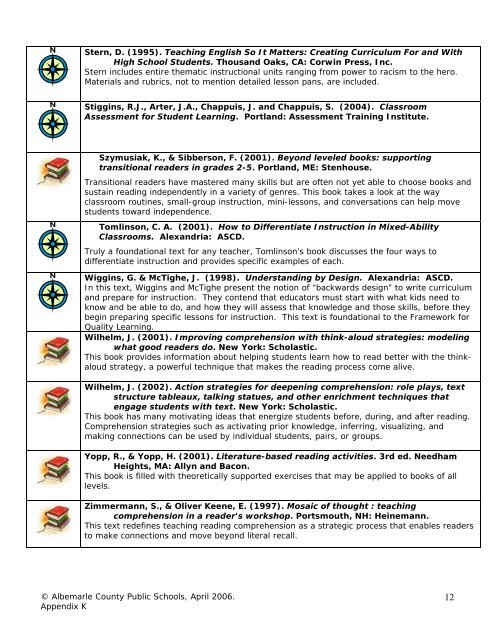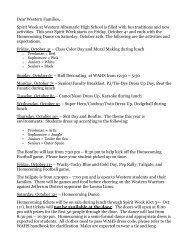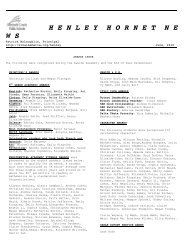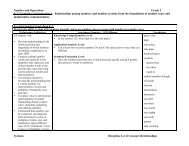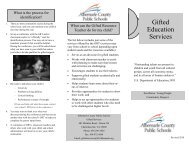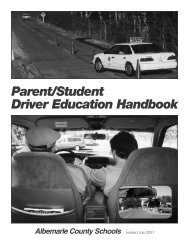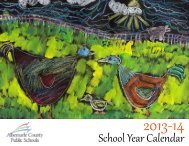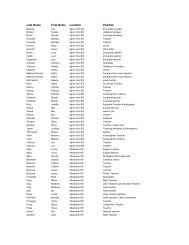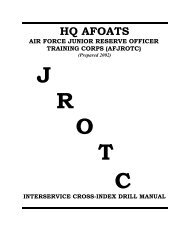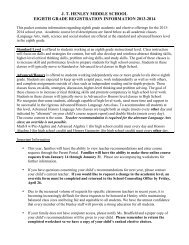Language Arts/English Curriculum Frameworks - Albemarle County ...
Language Arts/English Curriculum Frameworks - Albemarle County ...
Language Arts/English Curriculum Frameworks - Albemarle County ...
Create successful ePaper yourself
Turn your PDF publications into a flip-book with our unique Google optimized e-Paper software.
Stern, D. (1995). Teaching <strong>English</strong> So It Matters: Creating <strong>Curriculum</strong> For and With<br />
High School Students. Thousand Oaks, CA: Corwin Press, Inc.<br />
Stern includes entire thematic instructional units ranging from power to racism to the hero.<br />
Materials and rubrics, not to mention detailed lesson pans, are included.<br />
Stiggins, R.J., Arter, J.A., Chappuis, J. and Chappuis, S. (2004). Classroom<br />
Assessment for Student Learning. Portland: Assessment Training Institute.<br />
Szymusiak, K., & Sibberson, F. (2001). Beyond leveled books: supporting<br />
transitional readers in grades 2-5. Portland, ME: Stenhouse.<br />
Transitional readers have mastered many skills but are often not yet able to choose books and<br />
sustain reading independently in a variety of genres. This book takes a look at the way<br />
classroom routines, small-group instruction, mini-lessons, and conversations can help move<br />
students toward independence.<br />
Tomlinson, C. A. (2001). How to Differentiate Instruction in Mixed-Ability<br />
Classrooms. Alexandria: ASCD.<br />
Truly a foundational text for any teacher, Tomlinson’s book discusses the four ways to<br />
differentiate instruction and provides specific examples of each.<br />
Wiggins, G. & McTighe, J. (1998). Understanding by Design. Alexandria: ASCD.<br />
In this text, Wiggins and McTighe present the notion of “backwards design” to write curriculum<br />
and prepare for instruction. They contend that educators must start with what kids need to<br />
know and be able to do, and how they will assess that knowledge and those skills, before they<br />
begin preparing specific lessons for instruction. This text is foundational to the Framework for<br />
Quality Learning.<br />
Wilhelm, J. (2001). Improving comprehension with think-aloud strategies: modeling<br />
what good readers do. New York: Scholastic.<br />
This book provides information about helping students learn how to read better with the thinkaloud<br />
strategy, a powerful technique that makes the reading process come alive.<br />
Wilhelm, J. (2002). Action strategies for deepening comprehension: role plays, text<br />
structure tableaux, talking statues, and other enrichment techniques that<br />
engage students with text. New York: Scholastic.<br />
This book has many motivating ideas that energize students before, during, and after reading.<br />
Comprehension strategies such as activating prior knowledge, inferring, visualizing, and<br />
making connections can be used by individual students, pairs, or groups.<br />
Yopp, R., & Yopp, H. (2001). Literature-based reading activities. 3rd ed. Needham<br />
Heights, MA: Allyn and Bacon.<br />
This book is filled with theoretically supported exercises that may be applied to books of all<br />
levels.<br />
Zimmermann, S., & Oliver Keene, E. (1997). Mosaic of thought : teaching<br />
comprehension in a reader's workshop. Portsmouth, NH: Heinemann.<br />
This text redefines teaching reading comprehension as a strategic process that enables readers<br />
to make connections and move beyond literal recall.<br />
© <strong>Albemarle</strong> <strong>County</strong> Public Schools, April 2006.<br />
Appendix K<br />
12


